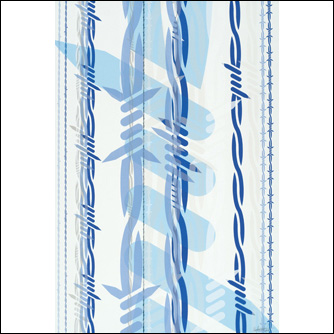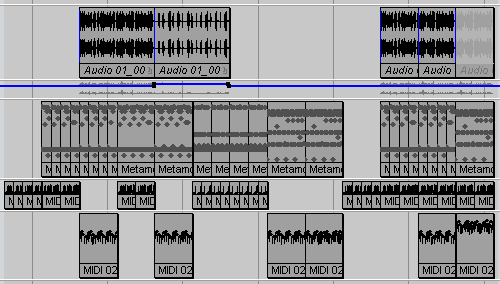View current page
...more recent posts

This jpeg of a print by Ryan McGinness comes from Paddy Johnson's blog. She's talking about the marketing of this image and this artist and it's worth a read to show you the mechanics of the hype and real estate and brand-building. I'm posting it on a slightly different topic, which is the "defaults" school of digital art. This strikes me as a very good example. It's got the flat "Adobe Illustrator look" but this artist doesn't make any bones about it. It's a preset, and he is using it very well. There's no getting around the content, either--any collector who buys the print will be looking through a prison camp fence, stylishly dressed up and tastefully layered as it might be. Several years ago I wrote about an installation by McGinness in a gutted building, soon to be renovated, on Lafayette--it also didn't hide the digital "facture." It was kind of the reverse of the above image--instead of a bleak adornment of a tony loft, the Lafayette show presented slick product logos on the inside of a "pre-owned" structure.
This post could probably read in tandem with one on Nasty Nets showing the similarity of some recent work by abstract/conceptual photographer James Welling and an Adobe Illustrator promotional graphic. Compare and contrast the relations of artists to well-known imaging software.
It could also be read together with my short interchange with a commenter about the use of presets in music (or more specifically the familiar interface Cubase.)
Recently relistened to Slapp Happy's Sort of, a gem from the early '70s that got extremely limited release in the '80s and is apparently available again after many years. Peter Blegvad has a Jonathan Richman/Lou Reed ish voice here and I don't know how to describe Dagmar Krause's except distinctive and pretty--certainly less emphatic on this LP than her later work with Henry Cow. The songs would be called indie today and they don't sound the least bit dated to me--according to the amazon review, at the above link, "Opal use to do a stoked cover of 'Blue Flower' live; their Mazzy Star reincarnation recorded it less successfully about ten years ago and never bothered to credit Slapp Happy." "Small Hands of Stone" and "Little Girls World" are a couple of my favorites. Some members of the German avant group Faust play on a few songs but again, there's nothing particularly prog or even psych about these tunes--some are country-inflected, others Feelies-ish. Solid songwriting, good singing & playing and smart lyrics. Worth grabbing if you come across it.

"Placeholder" [mp3 removed]
Dataisnature, April 9:
Sol LeWitt died yesterday. If you have had your eye on Dataisnature for a while, you will have heard his name mentioned a lot on these pages. Just after time of the 'heroic' gestures of Abstract Expression Lewitt conceived of a new language utilising simple impersonal forms in repetition and modulation, often drawing directly onto the wall. The fact that these Conceptual drawings were designed to be painted over solidified Lewitt’s claims that the 'idea behind the work supersedes the work itself' and that 'The idea becomes the machine that makes the art.' Prophetically for our times Lewitt also said that "Ideas cannot be owned. They belong to whomever understands them."This is a nice tribute and a good explanation of LeWitt's importance. Yet the early sentences on conceptual art were better than the somewhat boring process-based line drawings that resulted from them and those line drawings were better than the later, somewhat tacky ink wash drawings that became permanent fixtures of museums after LeWitt's canonization. Would that it were true that many works were "designed to be painted over." Also, I believe many artists using computers misunderstand LeWitt's relevance to them. The key sentences for me are the first ones:
The works are conceptual and aesthetically pleasing at the same time and Lewitt’s path eventually lead him to writing instructions for making a piece of art. These instructions meant that his works could be recreated anywhere and more importantly it represented a shift in 'artistic authority' from a centralised model to a distributed one. The idea of 'instruction based art' was incredibly forward thinking when we consider the contemporary practices of digital generative artists and their use of code and algorithms to make 'pictures.' More so the concepts and philosophies dealing with ownership have never been more relevant.
1. Conceptual artists are mystics rather than rationalists. They leap to conclusions that logic cannot reach. 2. Rational judgements repeat rational judgements. 3. Irrational judgements lead to new experience. 4. Formal art is essentially rational. 5. Irrational thoughts should be followed absolutely and logically.As Rosalind Krauss interpreted LeWitt,
the experience of the work goes exactly counter to 'the look of thought,' [which critics such as Donald Kuspit and Suzi Gablik were claiming for it] particularly if thought is understood as classical expressions of logic. For such expressions, whether diagramatic or symbolic, are precisely about the capacity to abbreviate, to adumbrate, to condense, to be able to imply an expansion with only the first two or three terms, to cover vast arithmetic spaces with a few ellipsis points, to use, in short, the notion of et cetera.
[....]
In Variations of Incomplete Open Cubes....what we find is the "system" of compulsion, of the obsessive's unwavering ritual, with its precision, its neatness, its finicky exactitude, covering over an abyss of irrationality.

Krauss compared the "Open Cubes" to the activities of an obsessive-compulsive in a Beckett novel who had an elaborate system for moving "sucking stones" between various pockets and his mouth (see earlier discussion re: Manfred Mohr). Yet many digital artists still fetishize logic and "the look of thought" with artworks based on data analysis and modeling, even more egregiously when the art purports to highlight or "solve" some social condition. (See generally VVork.) LeWitt is not really for them, only a recuperated idea of LeWitt.

GIF by eyekhan, enlarged
Firedoglake hosted a blog chat yesterday with Andrew Cockburn, author of Rumsfeld: His Rise, Fall and Catastrophic Legacy. Here are some quotes:
I spent a lot of time trying to figure out what, if anything, Rumsfeld believes in. The answer seems to be: very little, apart from an overriding desire to dominate each and every human encounter. Otherwise it has been hard to detect any thread of principle.And:
Well of course there was no transformation [of the military], at least not in any positive sense. His major legacy, apart of course from the wreckage inflicted on the army and marines thanks to Iraq, has been to let the budget spiral completely out of control, so that at a time when the Social Security and Medicare bills come due in a big way, we will find ourselves committed to footing the bill for defense obligations -- i.e., weapons programs -- that are militarily irrelevant and years late in entering service.Cockburn also suggests that it might not be wise for Dapper Don to visit Europe any time soon.
Blogs turned 10 this year (we think) and this was discussed on Server Side, here at the Tree. Dave brought up the New York Times' "Diagram of a Blog (sic)," a pitiful attempt to ridicule this upstart medium (or so I see it). Here's the reference in context (edited for length):
The first blogs I stumbled onto were like dull diaries, and everyone knows that a diary is only fun to read when it isn't intended for publication.Happy anniversary, blogs. Still caught in the media's throat, like a hairball.
- L.M. 4-03-2007 2:31 pm
I think most people still think of them as dull diaries. A fairly prominent blogger friend was recently on a sociopolitical panel (I'm not giving away too much) and beforehand the organizer said "it's nice that you keep a diary."
- tom moody 4-03-2007 2:39 pm
I think at least some of it has to do with the word 'blog'. I mean, how can you take that seriously? I remember when Peterme coined it, and the awkwardness of the word was a big reason I liked it. Almost like the practitioners were trying to be as uncool as possible. Around this same time Wired was trying to call them "Me-zines." That's just trying way to hard. Whereas blog sounds like something you might expectorate.
- jim 4-03-2007 4:04 pm
Wasn't me-zines Slate? As much of a problem as I had with "blog" (as you know) "me-zines" was orders of magnitude worse. I never thought about it as being deliberately uncool. Now, for that reason, I like it (6 years out)!
- tom moody 4-03-2007 4:08 pm
"Blog' still sounds uncool! It's like made out of anti-cool teflon or something.
- jim 4-03-2007 4:18 pm
i like when msm has to say "blog" in the context of having been scooped by one. like being beat by a child in chess.
- bill 4-03-2007 5:10 pm
critique of pure idiocy
- dave 4-06-2007 1:38 pm
"[Moqtada al-Sadr]'s fighters are not contesting US forces," says presidential aspirant and war hawk John McCain, a supporter of the Bush troop escalation that is supposedly pacifying Iraq, in a Washington Post editorial today.
From the same paper:
April 7 -- American and Iraqi troops engaged in fierce fighting with Shiite militiamen in southern Iraq on Saturday, the second day of clashes that have raised the specter of a resurgence by the Mahdi Army after weeks of lying low.Update, from the AP: "Al-Sadr Calls for Attacks on U.S. Troops." This can't be, "straight talk" McCain says he is "hiding."
As combat aircraft zoomed overhead, U.S. and Iraqi troops fought the militia in street shootouts and hunted down fighters in house-to-house raids in what the U.S. military said was an attempt to wrest control of the city of Diwaniyah from loyalists of firebrand Shiite cleric Moqtada al-Sadr. It was the third major clash between U.S.-allied forces and the Shiite militia in Diwaniyah in the past eight months.
